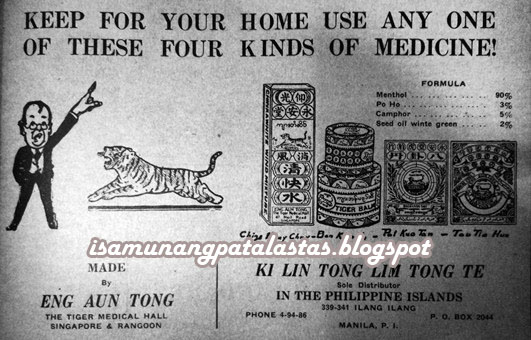 |
| THE TIGER BALM 'LEAPING TIGER' ICON |
One of the most famous heritage brands from Asia is a
special ointment for all kinds of aches and pains—TIGER BALM. The salve comes in small hexagonal bottles and circular
tin containers with a leaping tiger icon that has been in use for over a
century, attaining worldwide recognition and prominence.
 |
| A NEW TIGER BALM JAR, between 2 vintage Tiger Balm products, |
TIGER BALM’s
romantic origins began in the court of Chinese emperors where Chinese herbalist
Aw Chu Kin was employed. In the late 1870s, he decided to leave his homeland
and move to Rangoon (Burma, now Myanmar) where he opened a medicine shop and
called it Eng Aun Tong (Medical Hall) .
It was here that he concocted an ointment for body aches and pains, a
product that would soon make his business successful.
Upon his death in 1908, his sons Aw Boon Haw (a name that
means “gentle tiger”) and Aw Boon Par (“gentle leopard”) took over the
burgeoning business and set up operations in Singapore. It was Aw Boon Haw who
branded the product “TIGER BALM” in
1924 after his name. he was also the marketing genius behind its success, and
the product eventually found its way to China and other Southeast Asian
countries like Siam (Thailand), Batavia (Indonesia), Malaya (Malaysia),Hong
Kong and the Philippines.
 |
| THE TIGER MEDICAL HALL IN SINAGPORE |
By the late 1920s, TIGER
BALM was already available in local boticas and farmacias, with
Binondo-based Ki Lin Tong Lim Tong Te as its sole distributor. It was also
extensively advertised all through the 1920s-30s in leading magazines and
newspapers of the day.
 |
| 1929 TIGER BALM, Philippine ad. |
The product was most popular among the Chinese
communities around the world, and the business was a a huge success, turning
the brothers into rich tycoons.
 |
| 1929 TIGER BALM, Philippine ad. |
They engaged in philanthropic works, donating
money to charities, schools and newspapers in their adopted countries. Boon Par
not only built mansions, Singapore, Hong Kong and Fujian, but also a theme park--the
TIGER BALM Gardens.
 |
| TIGER BALM GARDENS, HONG KONG, postcard, 1960s |
After the brothers died (Boon Par in 1944 and Boon Haw in
1954), the TIGER BALM business
remained in quandary. It was soon taken over by British conglomerate Slater
Walker in 1969. But when the company was plagued with financial crisis, Singaporean
banker Dr Wee Cho Yaw gained control of the business in 1981 and began
rebuilding the company and, eventually the brand, TIGER BALM.
Today, TIGER BALM
is a flourishing brand available worldwide, distributed in countries such as
Brazil (Pomada del Tigre), Scandinavian countries (Tiger Balsam), France (Baume
du Tigre), Spain (Balsamo Tigre), Saudia Arabia and the U.S. where it was
positioned as a sport balm. TIGER BALM
is readily available in the Philippines, as t has been since the 1920s, in
leading drugstores and Chinese specialty shops.
SOURCES:






No comments:
Post a Comment